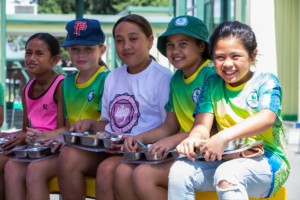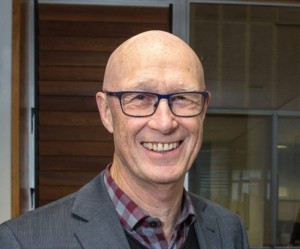
Students at Flaxmere Primary School with their lunches as part of Ka Ora, Ka Ako, the Government’s free school lunch programme.
Researchers at EIT and the University of Auckland (UoA) are calling for input from Hawke’s Bay schools to help assess the value of the Government’s free school lunch programme Ka Ora, Ka Ako, amidst threats of funding cuts.
The future of the programme is yet to be assured as Associate Education Minister David Seymour has asked that the government-funded lunch provision be reviewed ahead of the May Budget.
Professor Boyd Swinburn, a nutrition and global health expert at Te Kura i Awarua, the EIT Rangahau Māori Centre, says the comprehensive Value for Investment (VFI) evaluation of the Ka Ora, Ka Ako programme will be pivotal in shaping the future of free school lunches.
They have been researching the programme for several years as part of Nourishing Hawke’s Bay: He wairua tō te kai, a collaborative local project between EIT and UoA.
“We’re wanting to engage with principals in Hawke’s Bay to work with us on a zoom call later this month to go through the evidence and give ratings. If we can do that, and if we can get a good response from people who are actually at the coalface of this, then that will complete this piece of research, and we’ll have this full VFI analysis to be able to put to the government.”
A VFI is a pioneering approach to programme evaluation that incorporates stakeholder feedback to assess how effectively resources are utilised to achieve expected outcomes.
Through this method, they aim to identify and measure the true value created by Ka Ora, Ka Ako.
They have developed 21 specific criteria across five key domains – effectiveness, economy, efficiency, equity, and cost-effectiveness – to measure the impact and efficiency of Ka Ora, Ka Ako.
These criteria were refined with input from community and government stakeholders to ensure relevance and accuracy.
“Our goal is to determine the overall value produced by the resources invested and its potential to produce more value for tamariki, whānau, the community and the food system.”

Professor Boyd Swinburn
Professor Swinburn says now is “absolutely critical” to provide feedback to the government on the effectiveness of the programme.
“This program is really sitting on the chopping block and now, it’s critical to get the solid, robust evidence with feedback from the coalface to the decision makers in Wellington so they can make the right decision about the programme.”

